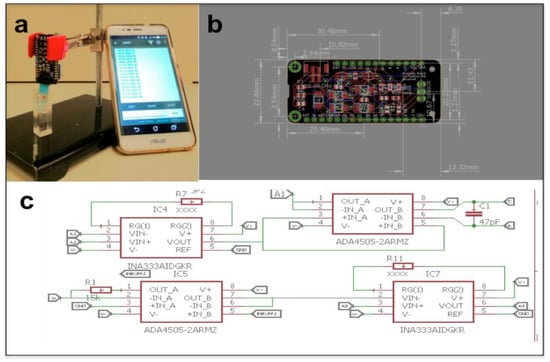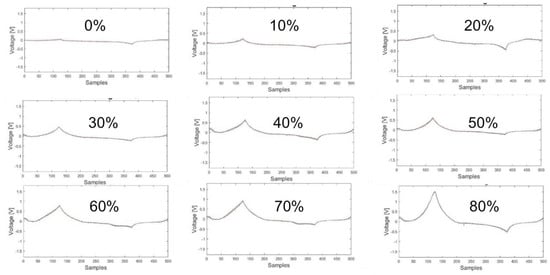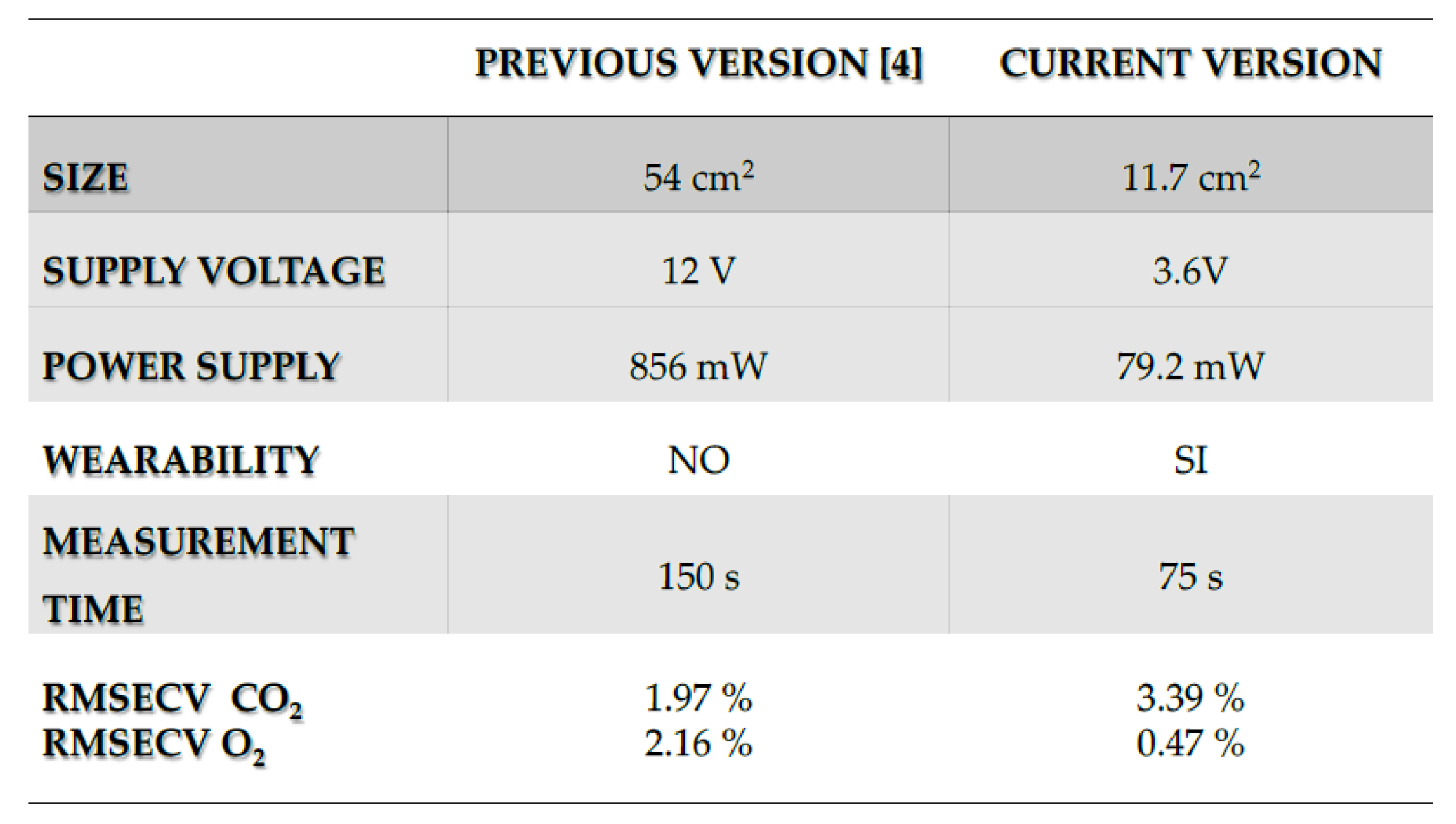Abstract
The technological development of the last few years in the field of integrated electronic components has encouraged the use of wearable electronic devices. In the biomedical field, this improvement allows the registration and analysis of numerous values, starting from environmental parameters up to the vital parameters of a subject, without interfering with the normal daily activities of the individual. In this context, the present work is focused on the design, development and evaluation of a low power wearable and wireless electronic interface able to acquire and transmit signals generated by a gas sensor, based on electrochemical technology, to monitor air quality through the measurement of O2 and CO2 concentration. Among the existing wireless technologies, it was decided to use Bluetooth Low Energy (BLE) as it allows data transmission to multiple types of external devices, such as PCs and smartphones with low power consumption.
1. Introduction
In a real life scenario, the monitoring of selected physico-chemical parameters could support the supervising of an individual activity allowing the simultaneous registration of data from the environment and on the subject health status [1,2]. The continuous monitoring of environmental parameters in a single device which is also wearable, wireless and low-power, could represent a brick to be added to the future realization of a wearable system formed by multiple devices. This system could allow the simultaneous detection and integration of environmental and vital parameters, to be used for an effective application of preventive medicine [3]. Very often, indeed, the health status of a subject is given by a series of vital parameters instead of a single one. Besides, the monitoring of environmental data such as gas concentration, temperature and relative humidity, could help identifying potential warning conditions giving rise to uncomfortable or warming situations. Oxygen and Carbon dioxide concentrations in air are crucial for indoor air quality, and practical indications can be found in literature about thresholds [4] to be frequently monitored. This study presents a sensor system, which is able to perform electrochemical analysis of O2 and CO2 concentrations in the environment [5], with very low power consumption and in wireless modality.
2. Experimental
The novel electrochemical sensing system is based on a previous developed device [5] and includes a Screen-Printed Electrode probe (SPE, DRP-250BT, Metrohm, Herisau, Switzerland), which acts as an electrochemical cell, a new dedicated electronic interface driving the electrode, a microcontroller for input/output signals and a BLE module to transmit data to an external device. The electronic interface was properly designed to achieve low power consumption (about 80 mW: 3.6V, 22 mA) and reduced size (about 12 cm2) (Figure 1).

Figure 1.
Developed sensor system analysing a liquid sample and transmitting data to a smartphone using a BLE connection: (a) experimental set-up using a smartphone; (b) layout of the electronic interface; (c) schematic of the electronic interface between the sensor and the controller.
Different mixtures of N2 and O2 or CO2 were fluxed into a 4 mL solution of saline and distilled water (in a ratio of 1:20) for 30 s to dissolve the gas into the liquid medium; the liquid sample was subsequently analyzed using the electrochemical sensing system. Tested O2 and CO2 concentrations ranged from 0% to 100% by steps of 10%. A sinusoidal input signal (0.2 Hz, ±2 Vpp) was applied to the electrochemical cell and the current generated by induced oxi-reduction phenomena was converted into a voltage and acquired as the output signal with a sampling rate of 100 Hz; thus the output signals consists of a cyclic voltammogram of 500 points. Data were sent to a smartphone using BLE connection. The entire output signal is treated as a fingerprint of the sample using a multivariate data analysis technique: Partial Least Square Discriminant Analysis (PLS-DA), cross-validated via the Leave-One-Out criterion.
3. Results
The sensing system has showed the ability to measure O2 and CO2 concentrations: PLS-DA models calculated on the calibration data set of each compound have shown Root Mean Square Error in Cross Validation (RMSECV), of 3.39% and 0.47% for CO2 and O2 respectively. The calibration results obtained with this new low-power and wireless system has been compared with the performance given by the first prototype [4]. The order of magnitude of the RMSECV is the same.
Moreover, looking at CO2 there is an increasing of the estimated detection limit of about 1.4%, while O2 detection limit has been lowered of 4 times. The interesting RMSECVs obtained via multivariate data analysis techniques suggest that the different concentration levels should be visible also by comparing the output voltammograms given by each concentration step tested during the calibration phase. In Figure 2 the output O2 signals for steps of 10% are shown. The registered curves are evidently different.

Figure 2.
Output voltage signals registered by the system for increasing concentrations of O2, from 0% to 80%. The range of interest for real application in the environment is round 20%. The system is able to follow variation round 0.5% around this threshold.
4. Conclusions and Future Developments
The Comparison between the low-power BLE gas sensor here presented and its previous version (see Table 1) tells us that the good performance in terms of reproducibility, resolution and sensitivity are preserved.

Table 1.
Comparison between the previous [4] and the current version of the gas sensors in terms of size, supply voltage, power supply, wearability, measurement time and RMSECV with respect to CO2 and O2.
In particular: size has been reduced of more than 4 times; supply voltage has been lowered of 3 times; power supply is 1/10 of the starting one; time needed to take a measurement has been halved. Concerning the estimated limits of detection, it is worth noting that this is a pilot study, because the IAQ documents indicate threshold lower than the RMSECVs here reported [6]. Size and power reduction, together with BLE connectivity open the way to the utilization of this sensor in a wearable system including other devices and to the possibility of using them in a network with other systems. Moreover, sensor calibration must be challenged down to 10-1% levels, in order to satisfy the IAQ requirements established in the official documents [4,6]. Looking at these indication by WHO (World Health Organization) and EU commission, it could be useful also to test these sensor for a series of other gas and pollutants.
Author Contributions
G.P. and M.S. conceived and designed the experiments; A.Z., F.M. and M.S. performed the experiments; L.V. realized device connectivity; S.G. and A.S. analyzed the data; A.D. and G.P. wrote the paper.
Acknowledgments
This work was partially funded by the 2016 FLAG-ERA project: (Frictionless Energy Efficient Convergent Wearables for Healthcare and Lifestyle Applications).
Conflicts of Interest
The authors declare no conflict of interest.
References
- Bandodkar, A.J.; Wang, J. Non-invasive wearable electrochemical sensors: A review. Trends Biotechnol. 2014, 32, 363–371. [Google Scholar] [CrossRef] [PubMed]
- Gao, W.; Emaminejad, S.; Nyein, H.Y.; Challa, S.; Chen, K.; Peck, A.; Fahad, H.M.; Ota, H.; Shiraki, H.; Kiriya, D.; et al. Fully integrated wearable sensor arrays for multiplexed in situ perspiration analysis. Nature 2016, 529, 509. [Google Scholar] [CrossRef] [PubMed]
- Andreu-Perez, J.; Leff, D.R.; Ip, H.M.; Yang, G.Z. From wearable sensors to smart implants-–toward pervasive and personalized healthcare. IEEE Trans. Biomed. Eng. 2015, 62, 2750–2762. [Google Scholar] [CrossRef] [PubMed]
- World Health Organization. WHO Guidelines for Indoor Air Quality: Selected Pollutants; World Health Organization: Geneva, Switzerland, 2010. [Google Scholar]
- Pennazza, G.; Santonico, M.; Zompanti, A.; Parente, F.R.; Ferri, G.; D’Amico, A. Design and Development of an Electronic Interface for Gas Detection and Exhaled Breath Analysis in Liquids. IEEE Sens J. 2018, 18, 31–36. [Google Scholar] [CrossRef]
- Available online: http://publications.jrc.ec.europa.eu/repository/bitstream/JRC83683/eca%20report%2029_final.pdf (accessed on October 2018).
Publisher’s Note: MDPI stays neutral with regard to jurisdictional claims in published maps and institutional affiliations. |
© 2018 by the authors. Licensee MDPI, Basel, Switzerland. This article is an open access article distributed under the terms and conditions of the Creative Commons Attribution (CC BY) license (https://creativecommons.org/licenses/by/4.0/).
